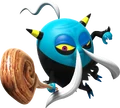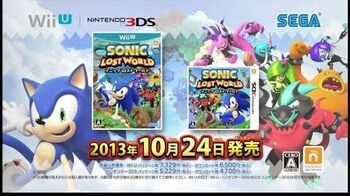- For the Nintendo 3DS version of the game, see Sonic Lost World (Nintendo 3DS).
- Not to be confused with Lost World, the similarly titled Sonic Adventure stage.
Sonic Lost World (ソニックロストワールド Sonikku Rosuto Wārudo?) is a 3D platforming video game in the Sonic the Hedgehog series, developed by Sonic Team and published by Sega in Japan and the Americas, and by Nintendo in Europe and Australia. It was released for the Wii U in October 2013. A Nintendo 3DS version of the game developed by Dimps also came out around the same time. The title features a Super Mario Galaxy-like gameplay, with Sonic travelling through spherical worlds and relying on unique parkour stunts to clear stages.
In Sonic Lost World, Sonic and Tails end up on the Lost Hex, a mysterious planetoid-like continent that floats over the Earth and that has been taken over by Dr. Eggman, who has enslaved a local group of "Zeti" known as the Deadly Six with the power to manipulate robots. When Sonic ends up freeing these very hostile creatures from the doctor's control, he and Tails must team up with their long-time nemesis to stop the Deadly Six, who have taken over Eggman's Badnik army and are using his Extractor to siphon all of the planet's life and make themselves invincible with it.
Compared to its predecessors, Sonic Colors and Sonic Generations, Sonic Lost World received mixed reviews, with criticism directed at the Deadly Six and the controls, but praise towards the visuals and music. The game was the first out of the several titles of Sega and Nintendo's exclusive collaboration, the others being Mario & Sonic at the Sochi 2014 Olympic Winter Games and Sonic Boom: Rise of Lyric/Sonic Boom: Shattered Crystal. In 2015, the Wii U version was re-released for the Steam service, with a few changes.
Plot[]
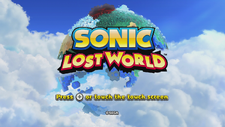
The title screen of Sonic Lost World.
At the beginning of the story, Sonic and Tails are chasing their long-time enemy Dr. Eggman and his robot henchmen, Orbot and Cubot, on the Tornado. Sonic demands Eggman to release the animals he is carrying in a capsule. Eggman complies with Sonic's demand but sends the animals falling to their doom. In an attempt to save the critters, Sonic spin dashes out of the Tornado, trying to unlock the capsule but misses the button on the capsule and before Tails is able to turn the Tornado around in order to give Sonic another chance to save the animals, Eggman fires a laser at the Tornado's wing, forcing the two to make an emergency landing on a mysterious floating continent known as "Lost Hex".
As Sonic and Tails go to rescue more animals under the request of Knuckles and Amy, Eggman has enslaved the Deadly Six, six demon-like creatures called Zeti, working for him. When Eggman says he wants Sonic destroyed, one of the Deadly Six, Zazz, goes after him, to which their leader, Zavok, is interested to find out more about him. Sonic defeats Zazz twice at Windy Hill.
After Tails fixes the Tornado, Sonic goes to Desert Ruins, where Eggman sends Zomom, the fat gluttonous Zeti, after Sonic. He is also revealed to be controlling the Deadly Six using the Cacophonic Conch which causes them pain if they disobey or offend him. After Sonic defeats Zomom the first time, Eggman activates a machine called the Extractor to drain energy from Earth so he can take it over. However, because the machine is unstable, he is forced to shut it down to avoid destroying Earth. Zavok eavesdrops at this event and expresses interest in doing so. After Sonic defeats Zomom a second time, he finds Eggman controlling the Deadly Six with his conch and kicks it away (ignoring Tails' warning not to). Because of this, the Deadly Six are now free of Eggman's enslavement and manipulate the magnetic fields around the Badniks and make them attack Eggman. In the resulting battle, Cubot's body is destroyed (with his voice chip damaged in the process) and Orbot takes his head to safety, while Tails is injured and Sonic grabs him to get him to safety. Sonic, Tails along with Eggman and the two robots escape from the battle.
As Sonic goes to Tropical Coast, the oldest member of the Deadly Six, Master Zik, goes to fight Sonic in order to test him. After Sonic defeats Zik the first time, Zomom expresses interest in killing and eating Eggman. Zavok decides to take revenge by destroying Earth and using its energy to increase their power and activates the unstable Extractor, which begins to drain Earth's energy. Amy, who is currently with Knuckles, tells Sonic of Earth's peril. After Sonic defeats Zik a second time, Eggman tells Sonic that the Deadly Six are destroying the earth. As destroying the Extractor would cause a cataclysmic explosion, Eggman must reprogram it to shut down. Thus, Sonic and Eggman must work together to stop the Deadly Six, against Tails' wishes, saying that they didn't need Eggman.
When Sonic enters Frozen Factory, after Tails fixes Cubot's broken voice chip (which made him talk like a pirate - again), he and Sonic get into an argument since Tails thinks that Sonic trusts Eggman more than him to shut the Extractor down, even though Sonic tries to explain himself. Zeena, the only female Zeti, is encountered by Sonic, but is busy with coating her nails. After Sonic defeats her twice, Orbot puts Cubot's head on a snowman. This inspires Tails to put his head on a destroyed Crabmeat. Eggman considers blowing up the Extractor to kill the Deadly Six even though it would mean killing many innocents. When Cubot turns aggressive and attacks Tails, Eggman unexpectedly saves him before Sonic knocks Cubot's head off, returning him to his senses. Sonic scolds Tails for nearly killing himself, further straining their relationship.
While at their base, Zavok begins to plan turning Sonic into a robot and make him their slave. Sonic, Tails and Eggman find a capsule in Silent Forest, and Sonic goes to activate it, but Tails realizes it is a trap and saves Sonic, but gets himself trapped inside the capsule, which is teleported to the Deadly Six's base. This makes Sonic grim and depressed. Zor, the sixth Zeti, and a depressing pessimist, encounters Sonic, and after Sonic defeats him, goes to tell the others that Sonic was not captured, but they have already found Tails in the capsule by now, and decide to use him for their plans instead.
Orbot goes to Sonic and asks if he can become Sonic's new sidekick if they don't find Tails, as he likes him better than Eggman; Sonic rejects the offer, saying that he will find Tails no matter the cost, but this only makes Orbot more inspired (in front of Eggman, no less). Cubot's head is attached to Orbot, much to their chagrin. Sonic fights Zavok at Sky Road and defeats him by knocking him off a robotic snake. Zavok survives, however, and plans to turn Tails into a robot and make him fight Sonic. As soon as Zavok and Zomom are out of sight, Tails grabs a toothpick in Zomom's sandwich with one of his tails and uses it to reprogram the machine.
When Sonic, Eggman, Orbot and Cubot enter Lava Mountain, they are attacked by Zazz and Zomom with boulders, causing the bridge, which they are standing on, to collapse and Orbot and Cubot fall toward the lava below. Eggman then grabs the remaining piece of the bridge and grabs Sonic's hand. Eggman then tosses Sonic onto solid ground before Eggman careens into the lava. Sonic looks down and searches for Eggman before he's forced to fall back. Zazz, Master Zik and Zomom then encounter Sonic and prepare themselves to destroy him. After seeing Amy apparently die from a lack of energy due to the Extractor's destruction, Sonic becomes even more desperate. Then Sonic encounters Zavok, Zeena and Zor, who try to convince Sonic to join them but to no avail. They then send Tails, seemingly modified into a robotic slave, after him. But Tails, due to his reprogramming the machine, is still himself and attacks the three Zeti, who retreat. Sonic fights them one by one, presumably defeating Zeena in battle before sending Zor and Zavok falling into the lava.
Sonic and Tails go to turn off the Extractor, but it has already been turned off by Eggman, who used a jet pack to avoid falling into the lava and saved Orbot and Cubot as well. He faked his death so he could be separated from Sonic and use the extracted energy to create a giant mech and take over what's left of the world. Sonic, however, defeats Eggman and his mech, foiling his plans. After that, Tails reprograms the Extractor to return all of Earth's energy and Sonic apologizes to Tails forever doubting him, mending their friendship. Eggman tries to fly away with his jet pack, but due to Sonic taking the exhaust hose from the jet pack, Eggman falls over a cliff, down to Earth. Sonic and Tails return to Amy and Knuckles, and Sonic takes a nap after "a day like today".
In a post-credits scene, it is revealed that Eggman survived his fall, falling into a soft spot of dirt. Orbot and Cubot get him out, but not before half his mustache is torn off by a rabbit, who mistakenly believes it to be a carrot. Cubot tries to reveal this to Eggman, but Orbot silences him. Eggman eventually hears them discussing it, however, and they promptly run off as he throws another tantrum.
Gameplay[]
The player controls Sonic the Hedgehog in an action platformer. The levels take place on tube-shaped worlds that shift in perspective, allowing for both 2D and 3D gameplay. Stages change and shift to use various gimmicks and aesthetics, from a candy-themed 2D level in Desert Ruins to a snowball pinball area in Frozen Factory to a stealth-centered area in Silent Forest. The boost-integrated gameplay from the more recent 3D titles has been eschewed in favor of a new control style, more similar to the control style found in the Sonic Adventure titles. The game brings back a few moves from Sonic's past, such as the Spin Dash, Bound Jump and Super Peel-Out. Also, an improved version of the Homing Attack that works similarly to the Light Speed Attack was introduced in the form of the Focused Homing Attack. The game introduces the "parkour" system, which allows Sonic to maneuver across obstacles and run on walls. The game also features new and returning Color Powers, a returning element from Sonic Colors and Sonic Generations, with exclusive Wisps for each version of the game. Similar to past installments in the series, the goal of each level is for the player to reach the end where the capsule is located. Smaller capsules can be found within the stages as well. Red Star Rings from Sonic Colors and Sonic Generations make a return, which like before can be collected for unlocking collectible content.
In the Wii U version, using the left control stick will move Sonic at a moderate pace, whilst holding down the right trigger button will engage his running speed. Pressing the left trigger allows Sonic to perform a Spin Dash. Sonic can jump with either A or B, but the B button will always double jump while the A button will perform the Homing Attack on any nearby enemies. By pressing the Y button, Sonic can perform a Flying Kick attack that destroys enemies the Homing Attack cannot. Miiverse is featured in the form of item-sharing, where players can obtain and share various capsules, such as Elemental Shields and Black Wisps that are exclusive to this feature. Collecting all of the Red Star Rings unlocks Super Sonic for normal gameplay. The game includes online leaderboards, where Sonic can race against time to earn the series' trademark Ranks- S, A, B, C, and D, depending on the level.
The Wii U version offers both competitive and cooperative multiplayer, but there is no online multiplayer mode. When playing in multiplayer mode, one player controls Sonic using the Wii U Gamepad while the other uses a Wii remote to either help (co-op) or race against the other player (versus).
Scoring system[]
Controls[]
| Button formation | |
|---|---|
| Move | |
| Jump | |
| Jump > |
Double Jump |
| Jump > |
Stomp |
| Dash | |
| Spin Dash | |
| Duck | |
| Lock-on > |
Homing Attack |
| Lock-on > |
Kick |
Objects[]
Items[]
| Image | Name | Description |
|---|---|---|

|
Ring | When Sonic takes damage while holding at least one, he does not lose a life.
Collecting 100 will give the player an extra life. |

|
Super Ring | Worth 10 Rings. |

|
Item Box | Holds an item or object inside, and releases it when hit. |

|
Red Star Ring | There are five located in each zone. Collecting all of them in a world will unlock
that world's Chaos Emerald. |

|
Number Ring | If the player collects all of them in descending order (from 5 to 1), they will
receive a 1-Up. |

|
1-Up | Gives the player an extra life when collected. |
Gimmicks and obstacles[]
Characters[]
Playable[]
- Sonic the Hedgehog
- Virtual Hedgehog
- RC Vehicles
- Miles "Tails" Prower (Circus minigame and Hidden World)
- Orbot (Circus minigame)
- Cubot (Circus minigame)
Non-playable[]
|
|
Deadly Six[]
The Deadly Six are a group of Zeti that plan to eliminate Sonic and take over the world once it is destroyed, the members are as follows:
| Name | Image | Description |
|---|---|---|
| Zavok | Zavok is the leader of the Deadly Six, being the member behind the destruction of the world and the depletion of Sonic. He is encountered at Sky Road. | |
| Zazz | Zazz is the more short-tempered and hot-headed member of the Deadly Six, though he harbours plans for the destruction of the world. He is encountered at Windy Hill. | |
| Zeena | Zeena is the only female member of the Deadly Six, who is also in the plan for the destruction of the world. She is encountered at Frozen Factory. | |
| Master Zik | Master Zik is the oldest member of the Deadly Six. He is encountered at Tropical Coast. | |
| Zomom | Zomom is the largest member of the Deadly Six. He is encountered at Desert Ruins. | |
| Zor | Zor is the most very depressed of the Deadly Six, as he hates upbeat or cheerful people. He carries a blue rose with him at all times. He is encountered at Silent Forest. |
Wisps[]
Being the third Sonic the Hedgehog game to feature the Wisps–intergalactic aliens that first appeared in Sonic Colors, the Wii U version of Sonic Lost World features five new Wisps along with four returning Wisps (five, if counting the White Wisps).
| Wisp | Color | Description | Color Power |
|---|---|---|---|

|
Black | The Black Wisp allows Sonic to transform into the Black Bomb Color Power, which can let Sonic explode and roll on foes. Can only be obtained via the Bonus Edition, DLC, or Miiverse. | 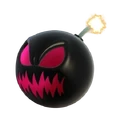
|

|
Crimson | The Crimson Wisp allows Sonic to transform into the Crimson Eagle Color Power, which can let Sonic soar through the air and perform a Light Speed Dash. | 
|

|
Cyan | The Cyan Wisp allows Sonic to transform into the Cyan Laser Color Power, which can let him shoot himself like a laser around Prisms. | 
|

|
Green | The Green Wisp allows Sonic to transform into the Green Hover Color Power, which gives Sonic the ability to fly around for a limited time in the air. The Light Speed Dash is available to use while using the Green Hover. | 
|

|
Indigo | The Indigo Wisp allows Sonic to transform into the Indigo Asteroid Color Power, which gives Sonic the power to destroy nearby objects and Badniks and make it debris for the Asteroid Ring to grow. | 
|

|
Magenta | The Magenta Wisp allows Sonic to transform into the Magenta Rhythm Color Power, which can let Sonic bounce around, flip upside down, and collect musical notes as a way of moving around. | 
|

|
Orange | The Orange Wisp allows Sonic to transform into the Orange Rocket Color Power, which can let Sonic burst into the sky as a rocket and skydiving after he transforms back to his regular form. | 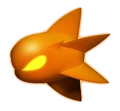
|

|
Yellow | The Yellow Wisp allows Sonic to transform into the Yellow Drill Color Power, which grants Sonic the ability to burrow through the ground or swim underwater for a limited time. | 
|
Enemies[]
|
Worlds[]
Sonic Lost World contains seven worlds, with each world having four zones. For the first time in the series, some zones can have a completely different theme or atmosphere, which can have different gameplay styles with old or new gimmicks and features. Bosses are encountered at the end of every second and fourth zone.
Windy Hill[]
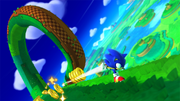
Windy Hill
Windy Hill is the first level of Sonic Lost World. Windy Hill has four zones; Zone One takes place in an open-field in a pasture of planetoids with an appearance similar to Green Hill Zone, the first level of the original Sonic the Hedgehog. Zone 2 takes place during a sunset that slowly comes to a midnight-setting of Zone 1, only in a 2D-perspective fashion. Zone 3 takes place inside a circular gem mine similar to Marble Zone (also from Sonic the Hedgehog), and Zone 4 is a daytime-setting theme that switches from a 3D-perspective to a 2D-perspective. Zazz is encountered twice in this level, at the end of both Zone 2 and Zone 4.
Desert Ruins[]
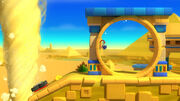
Desert Ruins
Desert Ruins is the second level of Sonic Lost World. Desert Ruins has four zones; Zone 1 is an open-field of ancient ruins located at a desert. Zone 2 takes place in a 3D behind-the-back perspective mach speed section gameplay which features Sonic running downward while at an area similar to a honeybee-hive. The gameplay of Zone Two is similar to Terminal Velocity from Sonic Colors. Zone 3 takes place in a 2.5D-perspective with an area full of sweets similar to Sweet Mountain from Sonic Colors. In fact, Zone 3 is actually dubbed "Dessert Ruins" on the opening card. Zone 4 takes place in a similar area as to Zone 1 of Desert Ruins, but in a 2D-perspective, which bears the zone resemblance to Sandopolis Zone from Sonic & Knuckles. Sonic is chased by a tornado throughout the level until he faces against Zomom. Zomom is encountered twice in this level, at the end of both Zone 2 and Zone 4.
Tropical Coast[]
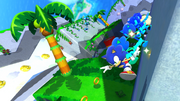
Tropical Coast
Tropical Coast is the third level of Sonic Lost World. Tropical Coast has four zones; Zone 1 is an open-field of an beach-styled planetoid. Zone 2 is a 2D-perspective zone, where giant fruits are shown to be used as obstacles. Zone 3 is a giant underwater tube filled with rails that Sonic can grind on, as well as giant robotic eels that pop up and try to attack Sonic. Zone 4 is similar to Zone 2, featuring the same fruit theme and gimmick. Master Zik is encountered twice in this level, at the end of both Zone 2 and Zone 4.
Frozen Factory[]
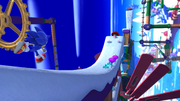
Frozen Factory
Frozen Factory is the fourth level of Sonic Lost World. Frozen Factory has four zones; Zone 1 is an open-field of a snowy planetoid full of machinery equipment used as gimmicks. Zone 2 takes place on an open-field, as well, but it takes place during the nighttime, as well as the fact that Sonic is now a snowball and that the player must roll Sonic around to get through the zone. Zone 3 takes place at a casino area that marks resemblance to Casino Night Zone from Sonic the Hedgehog 2. Zone 4 is a 2D-perspective zone similar to Zone 1 of Frozen Factory, but now Sonic can go through an actual factory location of the zone. Zeena is encountered twice in this level, at the end of both Zone 2 and Zone 4.
Silent Forest[]
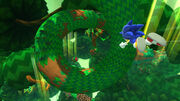
Silent Forest
Silent Forest is the fifth level of Sonic Lost World. Silent Forest has four zones; Zone 1 is an open-field of a giant forest with swamps and mud dominating the land on planetoids. Zone 2 is a 2D-perspective zone, which takes Sonic to a midnight-setting of a forest with several patches of ruins. Zone Three takes place inside an ancient ruins-based setting, which also takes elements from Zone 3 of Windy Hill. Zone 4, however, takes place also inside an ancient ruins, but this time the player must activate switches to turn on the lights, as the lights of the stage will go off and turn the screen almost completely dark. Zor is encountered twice in this level, at the end of both Zone 2 and Zone 4.
Sky Road[]
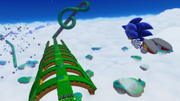
Sky Road
Sky Road is the sixth and penultimate level of Sonic Lost World. Sky Road has four zones; Zone One is a open-field planetoids located high above the sky during the daytime. Zone 1 bears resemblance to Sky Sanctuary Zone from Sonic & Knuckles. Zone 2 takes place in a same location as Zone 1, only it is in the middle of a thunderstorm where ruins of cities on clouds. Zone 3 is an zone similar to Zone 2, only that it takes place in a 3D-perspective plain than in the designs of Zone 2. Zone 4 returns back to daytime like Zone One, only in a side-scrolling view. Zavok is encountered twice in this level, at the end of Zone 2 and Zone 4. In the 3DS version of the game, Sky Road Zone 1 and Zone 2 are casino-themed instead of Frozen Factory.
Lava Mountain[]
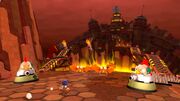
Lava Mountain
Lava Mountain is the seventh and final level of Sonic Lost World. Lava Mountain has four zones; Zone 1 is set on a planetoid, featuring a boss rush fight with Zazz, Zomom, and Zik. Zone 2 is similar to Zone 3 of Tropical Coast. Zone 3 takes place in an open-field behind-the-back perspective where lava dominates the ground as only stone-platforms are allowed to walk on, and throughout the level, Sonic rematches Zeena, Zor, and Zavok. In Zone 4, Dr. Eggman himself is the boss of this zone in a level very similar to the final boss of the Wii version of Sonic Colors and the remastered version Sonic Colors: Ultimate.
Hidden World[]
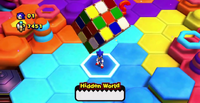
Exclusive to the Wii U version, after defeating Eggman in Lava Mountain Zone 4, there will be a colorful world with a hub map similar to Sky Road's map. This world is characterized by a colorful, abstract background and completely different gameplay in each zone.
Downloadable content[]
Nightmare Zone[]
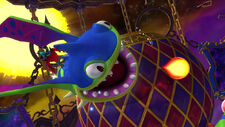
Sonic fighting Zavok and Gillwing in Nightmare Zone.
In the Deadly Six Bonus Edition and PC versions of the game, a bonus boss rush Zone based off of the Nights series featuring re-skinned versions of the first encounters of the Deadly Six battles, using the Nightmaren bosses from Nights into Dreams.
Yoshi's Island Zone[]
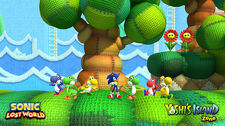
Sonic with several Yoshis in Yoshi's Island Zone.
This zone was available via downloadable content, and was free for owners of Sonic Lost World. This was released due to the launch of Yoshi's New Island. In the said DLC, Sonic can travel through a 2.5D side-scrolling zone featuring an influx of items, both Sonic the Hedgehog and Super Mario Bros.-themed. The level itself was removed in 2023 due to the closure of the Nintendo EShop.
The Legend of Zelda Zone[]
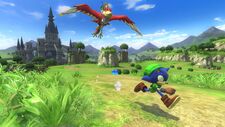
Sonic with Link in The Legend of Zelda Zone.
The Legend of Zelda Zone was the third zone available as downloadable content for Sonic Lost World. The Zone was based on Link's adventures in various games in The Legend of Zelda series. The player can roam freely in the open landscape of Hyrule, collecting Rupees and defeating enemies from The Legend of Zelda series. In this Zone, Sonic is dressed like Link and Link himself can be seen a few times as well. The level itself was removed in 2023 due to the closure of the Nintendo EShop.
Multiplayer[]

The versus race mode.
The Wii U version of Sonic Lost World contains versus races, where the player controls different colored Virtual Hedgehogs, who are previously seen in the Wii version of Sonic Colors. Numerous Zones are possibly redesigned for multiplayer modes. These multiplayer modes can have two players only, as one of the players can use the Wii U GamePad. Their gameplay is shown on the Wii U GamePad screen. Another player is able to control their playable character with a Wii remote or Wii U Pro Controller, while his/her gameplay is shown on the television screen. In the PC version, the multiplayer mode of the original Wii U version is lacked, however, its remnants still exist in the game files.
The Wii U version also includes a two-player Co-Op Mode, in which a second player with either a Wii Remote or Wii U Pro Controller can control an RC Vehicle to assist Sonic in single player stages. The player starts out with only the standard Helicopter, but can gain access to new vehicles, unlock different color variants or level up their vehicles by either completing specific Omochao missions, rescuing 11,000 Animals (and every 1000 thereafter), or connecting to the 3DS version. The Extra Stages, DLC Stages and Hidden World cannot be played in Co-Op.
Development[]

A screenshot showing Sonic and Tails riding towards Lost Hex. This was the first screenshot of game that was unveiled.
After the development for Sonic Colors ended, a few members of Sonic Team began experimenting with a new Sonic game. During this time, Sonic Team also planned to build a game which fully utilized the various features of the Nintendo 3DS. Eventually, between the release of Sonic Generations and the announcement of the Wii U, development for a PC version of Sonic Lost World had fully begun.[4][5] Sega eventually decided it would be best to develop the game for a Nintendo platform, considering Sonic's success on Nintendo consoles, and started to develop a Wii U version of the game, taking advantage of the Wii U's dual-screen capability and Gamepad. Once the basic stage structure and storyline was confirmed, a 3DS version of the game was added to the development.
After the positive reception of Sonic Colors's Color Powers, Sega decided to bring back the Color Powers for Sonic Lost World. The Color Powers were implemented from the outset, and provided the development team with a chance to utilize the GamePad. No other specific elements from Sonic Colors were brought into Sonic Lost World, as the game was intended to focus on pushing Sonic forward.
This time, Sonic Team wanted to create a game that was "100 percent Sonic". The combination of forward-view and side-view platform-action gameplay had been established as a staple of the series. But this time, Sega wanted to try something completely new with Sonic Lost World and provide a new experience by giving the player something Sonic had never experienced in the past twenty years. During one brainstorming session, the team suggested a "twisted tube-like level", drawing inspiration from the children's story "Jack and the Beanstalk".[5] The development team, however, had had no experience with this sort of level design. Just the first stage had to be created, broken down, recreated, and broken down again for half a year in order for the level to reach its finished state. Even more work went into the 3DS version's levels due to the system's processing power.[5] A parkour system was also designed specifically for the game, as it fit the level design nicely.[6] The development team, however, still attempted to maintain an equal balance between two-dimensional and three-dimensional platforming.
Sega officials Aaron Webber and Sam Mullen also revealed the reasoning behind some of the decisions Sega made in Sonic Lost World. According to the pair:
- "The whole parkour system, conceptually, comes from the simple fact that in past Sonic games, Sonic would move really fast and he was kind of uncontrollable, and then you'd run into objects and just stop. So we went back to basic controls and said, 'Okay, how to we get past this? People do not like running around fast, fast, fast and then stop.' It started out with really simple things, like when Sonic hit a corner he would just glance past it. So we thought, what if he runs up walls or grabs ledges? And it sort of evolved from there into the state it is now... It's a matter of giving players reasons to use that kick attack versus the homing attack, and having enemies where you'll have to use a certain combination, such as the homing attack and then a kick. It's really nice to have that kind of control in a Sonic game... It all boils down to the fact that we want the player to maintain a flow, even if they're not having a sort of perfect playthrough. This way, the flow of a high-level Sonic player can be enjoyed even by a novice player."[7]
At the Summer of Sonic 2013 convention, Takashi Iizuka stated that Sega wanted "Mario fans" to play Sonic Lost World, due to the slower-balanced platforming used in Sonic Lost World.[8] Iizuka also revealed that the game had been under development for a full two and half years, starting during Sonic Generations' development as a prototype of the different geometries.[citation needed]
Sega registered the trademark and the web address of the game's website on 16 May 2013,[9] a few days before the game was first announced at a presentation of Nintendo Direct on 17 May 2013.[10] According to Nintendo's Satoru Iwata, it was announced that Nintendo itself had entered into a worldwide partnership with Sega regarding the Sonic the Hedgehog series.[10]
Soundtrack[]

Sonic Lost World OST - Wonder World Main Title Theme-0
The music director for Sonic Lost World was Tomoya Ohtani, who was previously the music director for the soundtrack for Sonic Unleashed. The main theme of the game is called "Wonder World".
The official soundtrack of the game, Without Boundaries: Sonic Lost World Original Soundtrack, was released by Wave Master on 27 November 2013.
Release[]
Both the Wii U and the Nintendo 3DS versions of Sonic Lost World were released first in Europe on 18 October 2013. The US release of the game was originally meant to be on 22 October 2013, but was delayed to 29 October. Both versions of the game was be released in Japan on 24 October 2013. Because Nintendo and Sega worked cooperatively on the game, Sega released the game in US and Japan, while Nintendo worked as the distributor in European and Australian markets.[11]
Pre-ordering the Wii U version from Amazon in North America gave the player 25 extra lives as a pre-order bonus.[12] If the game was instead pre-ordered through GameStop, one would receive a rare "Sonic Omochao Gadget" RC tool to help collect Rings. Not much is different about this other than it looking like Sonic. One will receive a code in the email as well as on they receipt, depending on how they pre-ordered it.
Accessory Kits[]
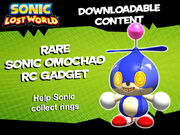
Sonic Omochao
Sega launched two accessory kits as collector items during the Japanese release of the game on 24 October 2013. The first kit contained a protection cover for Nintendo 3DS XL models and a small Sonic-themed storage bag. The kit also contained a bonus soundtrack CD for the game. The second kit contained blue earbuds and two small keychains, which were a pair of Sonic's Speed Shoes and Tails' set of tails.[13]
Deadly Six Bonus Edition[]
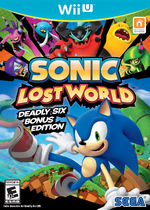
The Deadly Six Bonus Edition of the game.
Pre-ordering the game would grant the player the "Deadly Six Bonus Edition" (known as "Deadly Six Edition" in PAL regions) that includes DLC content. This promotion was exclusively for the Wii U was only available for a limited time.
This bonus edition contains Nightmare Zone with different boss fights from the original version that take place in the world of the Nights series. These boss fights are featured in the extra level, where all Deadly Six members are riding boss characters from Nights into Dreams. By pre-ordering the exclusive version of the game, the player is able to obtain the Black Wisp, originally found at Miiverse.
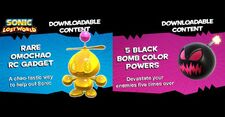
The second DLC description.
More pre-order DLC was available Sonic Lost World; this DLC includes a golden Omochao RC Vehicle that the second player can use while helping Sonic out in levels. The second pack includes five more Black Wisps, as they can transform Sonic into the Black Bomb Color Power.
The third DLC includes Yoshi's Island Zone, which its elements are based on the Yoshi series. There is another DLC that was released featuring The Legend of Zelda Zone themed around The Legend of Zelda series.
PC release[]
Two years after the game's release, on 2 November 2015, the Wii U version was re-released to the PC via Steam.[14] On 6 October 2015, Sega Europe's Twitter account confirmed the PC release.[14][15] The Steam version of the game includes the Nightmare Zone DLC and a solid frame rate of 60FPS.[16] The PC version of Sonic & All-Stars Racing Transformed was offered as a free bonus for pre-purchasing the game.[17]
Cast and Voice Direction[]
Jack Fletcher was the voice director for the English dub, Eriko Kimura was the voice director for the Japanese dub, Antoine Nouel was voice director for the French dub, Alice Bongiorni was the voice director for the Italian dub, Michael Hülsmann was the voice director for the German dub, and Guillermo Reinlein was the voice director for the Spanish dub.
Reception[]
| Reception | |
|---|---|
| Aggregate scores | |
| Aggregator | Score |
| GameRankings | 62[18] |
| Metacritic | 63%[19] |
| Review scores | |
| Publication | Score |
| Computer and Video Games | 7/10[20] |
| Destructoid | 7.5/10[21] |
| Edge | 4/10[22] |
| Eurogamer | 4/10[23] |
| Famitsu | 36/40[24] |
| Game Informer | 5/10[25] |
| GameSpot | 5/10[26] |
| GamesRadar | 4/5[27] |
| GameTrailers | 7.6/10[28] |
| IGN | 5.8/10[29] |
| Official Nintendo Magazine | 80%[30] |
| Polygon | 6/10[31] |
| VideoGamer | 5/10[32] |
| Empire | 2/5[33] |
Sonic Lost World received mixed reviews from critics. The Wii U version of the game received a score of 63% from review aggregator Metacritic,[19] and 61.95% from GameRankings.[18]
During its opening week in the UK, Sonic Lost World charted at #11 on the All-formats chart for sales, while also achieving the top spot on the Wii U chart.[34] As of the end of 2013, Sega had shipped 640,000 copies of the game.[35] As of 31 March 2014, the game had sold 710,000 copies.[36]
The game's presentation was well received. Chris Plante of Polygon praised the game's visuals and music as "arguably the best" in the series.[31] Game Informer's Tim Turi wrote that "the orchestrated tracks evoke Mario Galaxy in the best ways."[25] GameSpot's Mark Walton[26] and Computer and Videogames's Chris Scullion[20] singled out the candy-themed "Dessert Ruins" level as a visual highlight. However, Turi made note of "ultra-compressed" cutscenes in the 3DS version.[37] IGN's Vince Ingenito was favorable to the "pleasant" art direction and stable framerate, but criticized the "subdued" color palette.[29] Roger Hargreaves of Metro stated that the "imaginative" designs and "spectacular set piece[s]" kept him "interested to know what comes next."[38] Chris Schilling of Eurogamer was even more effusive: "Blue skies forever!"[23]
Strong criticism was directed at the game's control scheme, especially the new parkour mechanic. Turi "never got a good feel for the rhythm of wall running and jumping, and felt lucky to pass sections where it was forced."[25] Hargreaves,[38] Walton,[26] and Official Nintendo Magazine's Matthew Castle[30] agreed. Ingenito found it problematic that Sonic tends to wall-run on every nearby vertical surface.[29] Schilling singled out the multi-lock homing attack, writing that while "most of the time it works perfectly well," it appeared to "inexplicably fail" on occasion.[23] Ingenito,[29] Turi,[25][37] and Hargreaves agreed.[38] Matthew Castle of Official Nintendo Magazine struggled with the homing attack "locking on too late or attacking enemies in awkward sequence."[30] However, GamesRadar's Justin Towell defended the control scheme, explaining that while it had a learning curve, it also "modernize[s] environmental traversal" and "provide[s] a distinct safety net." Towell argued that Sonic was mainly hard to control in the "more complex 2D sections" because there are "so many rules for how Sonic reacts contextually to his environment."[27] Reona Ebihara of Famitsu stated that the ability to slow down made the game easier to play for beginners.[24] However, Turi criticized Sonic's "odd sense of momentum" and imprecise jumps,[25] stating that switching between two speeds is "jarring" and produces "touchy platforming."[37] Schilling excoriated the "profoundly frustrating" controls as the worst in the series, explaining that "Sonic's too sluggish while walking, and too skittish to cope with the trickier platforming bits when running."[23] Ingenito agreed: "I've played a lot of Sonic over the years, and the controls have never felt as alien and inconsistent as they do here."[29]
Reaction to the game's level design was mixed. Turi made note of oddly placed invisible springs in the game's "confusing" and "aggravating" levels. Walton preferred the "inoffensive" 2D sections to the "frustrating mishmash of speed and exploration" found in 3D.[26] Plante praised the game's 3D stages as "wildly creative exercises in platforming experimentation" while decrying its 2D stages as "so clunky and tiresome that it's hard to imagine a time when a side-scrolling Sonic was actually good."[31] Ingenito stated that the game's levels were stuck in "design gridlock" and "lack[ed] rhythm and cohesion."[29] Castle stated that the Wii U version's "best stages play to the strengths of Sonic's tiered speed."[30] Totilo praised "the intuitive, flowing, player-friendly levels of the 3DS version" but panned "the badly-explained, choppy, punitive levels of the Wii U version."[39] Schilling wrote that he "came perilously close to biting [his] GamePad at one particularly sharp difficulty spike."[23] Edge noted that "Sonic games, and platformers in general, have always been about memorizing the lay of the land, but rarely have mistakes been so costly or heavily punished."[22]
The alternate gameplay styles polarized many critics. Daniel Cairns of VideoGamer.com highlighted the level where Sonic becomes a giant snowball as "genuinely excellent"[32] and "a cool riff on Monkey Ball,"[30] whereas Turi and Ingenito described it as "atrocious,"[25] "uncontrollabl[e]," and "the exact opposite of fun."[29] Turi "received multiple game overs during a mundane mandatory pinball sequence."[25] Walton felt that some of the Wisps were an "amusing aside," while others suffered from "frustrating motion controls."[26] GameTrailers' Justin Speer stated that the Wisps "don't really feel like they belong" in the game.[28] Totilo preferred how the Wisps were used in the 3DS version,[39] but Towell stated that while they were "more integral" to the design, they tended to interrupt "the free-form gameplay" with "clumsy mechanic[s]."[40] Totilo and Castle criticized the Wii U version's Jetpack Joyride-style flying levels as "regrettable"[39] and "horribly imprecise."[30] Turi and Totilo criticized the game's balloon-popping minigame as "mind-numbing"[25] and "awkward."[39] Turi called the co-op mode "useless,"[25] although Seedhouse believed it was "suitable for families with younger players."[41] Castle wrote that "two-player races would be a cool addition were it not for the horrible framerate issues."[30]
The Deadly Six were negatively received. Although Towell enjoyed their "fun, stereotypical personalities," he was disappointed by their "awful" dialogue.[27] Speer called the boss battles "weirdly anticlimactic,"[28] and Ingenito stated the characters were "some of the most boring in the series' history,"[29] Turi referred to the Deadly Six as "generic," "forgettable," and "some of the most aggressively annoying villains ever."[25]
Critics disagreed over what to make of the game as a whole. Destructoid's Jim Sterling said it "can wildly swing from brilliant to horrific at the drop of a hat, but when one steps back and takes a look at the whole production, one sees far more to love than hate."[21] Plante noted that "the early stages display a degree of design ingenuity and polish which gradually degrades."[31] Empire's David McComb called it "A cheap, cruel, crushing disappointment in the wake of Sonic Colors and Generations."[33] Walton concluded that "in overtly coveting the great Italian plumber, it smothers the talents of its blazing blue hedgehog."[26]
Comic adaptation[]

The cover of Sonic Super Special #9.
In Sonic Super Special #9, published by Archie Comics, an adaption of Sonic Lost World is presented which is written by Ian Flynn, head writer for the Sonic the Hedgehog comic series and its spin-offs. This story serves as a prequel to Sonic Lost World and tells about how Dr. Eggman first came to the Lost Hex and enslaved the Deadly Six and how Sonic and Tails began their hunt and subsequent chase after the doctor in the beginning of the game. This story is twenty pages long, making it to this day the longest game adaption featured in Archie Comics. It was later stated by head writer Ian Flynn that the story actually would be canon to the main continuity in the comics "later".
Before the release of Sonic Super Special #9, this single story alone is also featured as a separate free comic in many comic shops across America as a part of a "Free Comic Book Day" event held during the Halloween season.[42]
Update history[]
- Version 2.0.0 (release day)
- Added support for preorder DLC.
- Version 3.0.0 (10 December 2013)[43]
- Collecting 100 Rings now grants an extra life.
- The number of lives granted after continuing from a Game Over has been increased from 5 to 10.
- The Indigo Asteroid, Crimson Eagle, Orange Rocket, and Black Bomb Color Powers can now be controlled with
 .
. - Fixed the strobe graphical glitch that occasionally occurred in the pinball sections of Frozen Factory Zone 3.
- Upon completing the Nightmare Zone, players will be notified that they can replay it after scoring 10,000 points.
- Items now appear on the world map.
- (Not listed) Added support for additional DLC.
- Version 4.0.0 (27 March 2014)[44]
- Added support for the The Legend of Zelda Zone DLC.
Trivia[]
- This is the first 3D mainline Sonic game since Sonic the Hedgehog (2006) to not utilized the Boost formula.
- This game shares its name with an action stage from Sonic Adventure.
- The music used in the debut trailer is an instrumental version of "Cinema" by Benny Benassi.[45] The Nintendo 3DS version's trailer uses an instrumental version of "Game Boy" by Invigilators x Ceezlin.
- This is the first 3D Sonic game since Sonic the Hedgehog (2006) to feature Item Boxes in 3D stages.
- The game shares some similarities with Sonic X-treme, a canceled game for the Sega Saturn. Both games have a story where six creatures get out of Eggman's grasp (which was one of several stories for the latter), both have a first stage inspired by Green Hill Zone (the former being Windy Hill and the latter Jade Gully Zone), both have freely floating level structures and both have gravity playing a key role. Despite Sega of America employee Aaron Webber noting the game was an influence, Takashi Iizuka has claimed that the developers of Sonic Lost World did not know about Sonic X-treme, meaning it had no intended influence on Sonic Lost World whatsoever.
- It also shares some similarities with Super Mario Galaxy, another game that has freely floating, circular level structures, traveling between several planetoids, and has gravity playing a key role. Windy Hill Zone 1's segmented structure resembles the levels from the Super Mario Galaxy series of games and Super Mario 3D Land.
- Takashi Iizuka has admitted that Sonic Lost World had "ended up a bit too close to Super Mario Galaxy"[46]
- It also shares some similarities with Super Mario Galaxy, another game that has freely floating, circular level structures, traveling between several planetoids, and has gravity playing a key role. Windy Hill Zone 1's segmented structure resembles the levels from the Super Mario Galaxy series of games and Super Mario 3D Land.
- In the first gameplay footage of the Nintendo 3DS version, the Invincibility and Speed Shoes theme was an instrumental version of "Sonic Heroes", but in the final project the Speed Shoes music was replaced with an instrumental version of "Reach for the Stars." The Wii U version still retains "Sonic Heroes."
- In a 2017 interview with Famitsu commemorating the release of Sonic Forces, Morio Kishimoto, the director of both games, stated that Sonic Lost World was restricted from having any vocals in its soundtrack, as a request from overseas.[47]
- This is the only main series Sonic game to be released on the Wii U, and the second main series Sonic game to be released exclusively for Nintendo platforms, with the first being Sonic Colors.
- In addition, it is the first main series Sonic game to be released on an eighth generation console.
- Before Version 3.0.0 was released, the player would not receive an Extra Life upon collecting one hundred Rings.
- The lives counter, timer, animal counter, and Red Ring counter will normally only appear when Sonic is at a completely dead stop, but occasionally show up when Sonic destroys an enemy, gets Rings or an extra life, or collects Red Star Rings.
- This is the fifth home console Sonic game to be rated E10+ by the ESRB.
- This is the first Sonic game in which Eggman actually calls Orbot and Cubot by their names, after he did not do so in Sonic Colors.
- This game has more major antagonists than any other game where Sonic and Eggman team up, with six in total.
- Sonic Lost World is the third game in the entire Sonic the Hedgehog video game series in which Dr. Eggman is seen holding a gun, the previous two being Sonic Adventure 2 and Sonic Riders. Unlike in those games, Eggman actually uses the gun in this game.
- This game has a similar twist as the Nintendo 3DS game Mario & Luigi: Dream Team, as the series antagonist (Bowser/Eggman) is seemingly overshadowed in their role by another villain (Antasma/Zavok) who they temporarily work with, only to reveal themselves as the true main villain by using a character to help them further a secret goal (Bowser uses Antasma, while Eggman uses Sonic), and become the final boss, while Antasma and Zavok serve as the second to last boss.
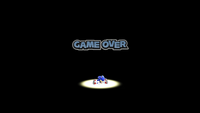
The Game Over screen in the Wii U version of Sonic Lost World.
- The Game Over screen of the Wii U version of Sonic Lost World is heavily reminiscent of the Continue screen from the original Sonic the Hedgehog.
- This is the first game to have Orbot and Cubot as playable characters, but only in the Circus minigames.
- This is the second 3D Sonic game to not have a vocal main theme, the first being Sonic Generations.
- There are numerous grammatical errors in this game. For example, when Zazz says, "Right, Master?", the subtitles read "right Master?". Also, Sonic says "Wow" at one point, but the subtitles state that he said "Whoa". At another point, he says: "Man", while the subtitles say: "Oh, man".
- In one cutscene, Orbot is seen holding Cubot's head and saying, "Alas, poor Cubot, I knew him well," a clear reference to the famous "Alas, poor Yorick" scene from William Shakespeare's Hamlet.
- In the opening cutscene, the Tornado's wing gets shot, but in the cutscene at the end of Windy Hill, Tails says that he fixed the plane's propeller.
- In the Wii U/PC version of Sonic Lost World, there is a strange glitch in Frozen Factory Zone 3 which gives the illusion of an epileptic seizure.
- The Yoshi's Island DLC marks the first time where there is interaction between the Mario and Sonic series in a main series title.
- The Legend of Zelda DLC is the second time the Sonic franchise has interacted with a Nintendo franchise that wasn't Mario, the first being Super Smash Bros. Brawl.
- Super Sonic isn't completely animated with certain movements in the game. For example, Wall-Jumping will result in a yellow-colored normal Sonic rather than Super Sonic.
- Unlike Sonic Generations, each voice actor for Sonic also voices the Wisp announcer in their respective audio tracks - except in Japanese, in which Fumihiko Tachiki still reprises that role since Sonic Colors.
- On several occasions, the voices and the subtitles don't line up correctly. For example, when Sonic is talking to Zeena, Sonic says, "Oh, no, what I meant to say is I am so sorry that you have nothing more important to do in life," but the subtitles read, "Oh, no, what I meant to say is I am so sorry you have nothing more important to do in life."
- During some of the cutscenes, Eggman is shown to run in an odd way. This happens to match his running animation while he is in the Chao Garden in Sonic Adventure 2.
- This is the second game in which Eggman saved Sonic from falling into a lava pit, the first being the Sonic the Hedgehog 2 (8-bit).
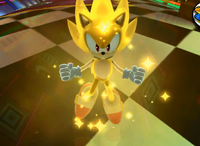
Super Sonic's mouth error.
- The Wii U version of Sonic Lost World has a rendering bug that leaves Super Sonic with a mouth on each side of his muzzle.
- The 2014 edition of Guinness World Records Gamer's Edition erroneously stated that Sonic Lost World was released on the Nintendo DS.
- There is unused data present in the game's files for the Blue Cube and Pink Spikes Color Powers, as well as an unused Snake transformation.[48]
- The animations for the Spin Dash are reversed in this game compared to previous games. The wind up in previous games is the traveling animation in this game, and vice versa.
- Sonic's death sound effects and the impatient falling animation where he looks at the camera were reused in Sonic Forces.
Videos[]
Cutscenes[]
References[]
- ↑ Sajid (@Sajidur78) on Twitter. Twitter (15 January 2021). Retrieved on 24 November 2022. "Sajid: Now for the more technical parts, Colors and Lost World share a lot of code. For instance, the Universe library and the set object manager is pretty much the same, screenshots below. Some arguments appear incorrect because of the decompiler."
- ↑ Sonic Lost World (Wii U) Australian instruction booklet, pgs. 1-4.
- ↑ Kellie (18 December 2013). Sonic Lost World – Yoshi's Island DLC Now Available!. SEGA Blog. Sega. Archived from the original on 16 July 2015.
- ↑ King, Ashley (29 July 2013). Sega explains why Sonic Lost World is Nintendo exclusive. Archived from the original on 28 June 2014.
- ↑ 5.0 5.1 5.2 Whitehead, Thomas (16 October 2013). Interview: SEGA On Bringing Sonic Lost World to Wii U and 3DS. Nintendo Life.
- ↑ Swiss (9 August 2013). SUMMER OF SONIC 2013: TAKASHI IIZUKA INTERVIEW. Sonic Stadium.
- ↑ Corriea, Alexa Ray (23 September 2013). Sonic: Lost World pays homage to the series' past while revamping for the future. Polygon.
- ↑ Iizuka: “We want Mario players” for Sonic Lost World. TSSZ News. Archived from the original on 15 August 2014.
- ↑ Berry, Jason (16 May 2013). SEGA TRADEMARKS “SONIC LOST WORLD(S)”. Sonic Stadium.
- ↑ 10.0 10.1 Nintendo Direct 5.17.2013. YouTube. Nintendo (17 May 2013).
- ↑ Martin, Matt (17 May 2013). Sega Europe hands Sonic publishing duties to Nintendo. Games Industry.
- ↑ Kellie (1 October 2013). Pre-Order Sonic Lost World at Amazon and Get 25 Extra Lives. SEGA Blog. Sega. Archived from the original on 4 October 2013.
- ↑ Sonic Lost World se paie des kits d'accessoires (French). Sega Mag (18 July 2013).
- ↑ 14.0 14.1 Sonic Lost World's Wii U Exclusivity Ends With Budget PC Release. Nintendo Life (6 October 2015). Retrieved on 6 October 2015.
- ↑ SEGA of Europe on Twitter. Twitter (6 October 2015). Retrieved on 6 October 2015. "The blue blur spins on to Steam with Sonic Lost World, coming November 2nd"
- ↑ Makuch, Eddie (6 October 2015). Previously a Wii U/3DS Exclusive, Sonic: Lost World Coming to PC With 60FPS Support. GameSpot. Retrieved on 31 March 2022.
- ↑ Sonic Lost World Coming To PC. Sonic Stadium (6 October 2015). Retrieved on 6 October 2015.
- ↑ 18.0 18.1 Sonic: Lost World for Wii U. GameRankings. Retrieved on 6 December 2013.
- ↑ 19.0 19.1 Sonic: Lost World for Wii U Reviews. Metacritic. Retrieved on 6 December 2013.
- ↑ 20.0 20.1 Scullion, Chris (18 October 2013). Review: Sonic Lost World stumbles at high speed. Computer and Video Games. Retrieved on 6 December 2013.
- ↑ 21.0 21.1 Sterling, Jim (18 October 2013). Review: Sonic Lost World. Destructoid. Retrieved on 13 December 2013.
- ↑ 22.0 22.1 Edge Staff (18 October 2013). Sonic: Lost World review. Edge Online. Retrieved on 13 December 2013.
- ↑ 23.0 23.1 23.2 23.3 23.4 Schilling, Chris (18 October 2013). Sonic Lost World review. Eurogamer. Retrieved on 13 December 2013.
- ↑ 24.0 24.1 Gifford, Kevin (18 October 2013). Japan Review Check: Sonic: Lost World, Armored Core, BlazBlue. Polygon. Retrieved on 15 December 2013.
- ↑ 25.0 25.1 25.2 25.3 25.4 25.5 25.6 25.7 25.8 25.9 Turi, Tim (18 October 2013). Sonic Lost World: Lost and Damned. Game Informer. Retrieved on 13 December 2013.
- ↑ 26.0 26.1 26.2 26.3 26.4 26.5 Walton, Mark (18 October 2013). Sonic: Lost World Review. GameSpot. Retrieved on 13 December 2013.
- ↑ 27.0 27.1 27.2 Towell, Justin (2013-10-18). Sonic Lost World review. GamesRadar. Retrieved on 2013-12-13.
- ↑ 28.0 28.1 28.2 Speer, Justin (18 October 2013). Sonic Lost World Review. GameTrailers. Retrieved on 13 December 2013.
- ↑ 29.0 29.1 29.2 29.3 29.4 29.5 29.6 29.7 Ingenito, Vince (18 October 2013). Sonic Lost World Review. IGN. Retrieved on 13 December 2013.
- ↑ 30.0 30.1 30.2 30.3 30.4 30.5 30.6 Castle, Matthew (18 October 2013). Sonic: Lost World Wii U review. Official Nintendo Magazine. Archived from the original on 11 November 2014. Retrieved on 13 December 2013.
- ↑ 31.0 31.1 31.2 31.3 Plante, Chris (18 October 2013). Sonic: Lost World review: Living in the Past. Polygon. Retrieved on 13 December 2013.
- ↑ 32.0 32.1 Cairns, Daniels (18 October 2013). Sonic Lost World Review. VideoGamer.com. Retrieved on 13 December 2013.
- ↑ 33.0 33.1 McComb, David (18 October 2013). Sonic Lost World Review. Empire. Retrieved on 14 December 2013.
- ↑ East, Thomas (21 October 2013). UK chart: Skylanders beats Pokemon X and Y, Sonic misses out on top ten. Official Nintendo Magazine. Archived from the original on 2014-11-11. Retrieved on 13 December 2013.
- ↑ Campbell, Evan (7 February 2014). Sonic: Lost World Ships 640,000, SEGA Game Sales Down. IGN. Retrieved on 24 February 2014.
- ↑ Yin-Poole, Wesley (9 May 2014). How are Sega's video games selling?. Eurogamer. Retrieved on 9 May 2014.
- ↑ 37.0 37.1 37.2 Turi, Tim (29 October 2013). Sonic Lost World: Another Portable Misstep For Dimps. Game Informer. Retrieved on 13 December 2013.
- ↑ 38.0 38.1 38.2 Hargreaves, Roger (18 October 2013). Sonic: Lost World review – galaxy class?. Metro. Retrieved on 13 December 2013.
- ↑ 39.0 39.1 39.2 39.3 Totilo, Stephen (18 October 2013). Sonic: Lost World: The Kotaku Review x2. Kotaku. Retrieved on 13 December 2013.
- ↑ Towell, Justin (18 October 2013). Sonic Lost World 3DS review. GamesRadar. Retrieved on 13 December 2013.
- ↑ Seedhouse, Alex (18 October 2013). Sonic Lost World (Wii U) review. Nintendo Insider. Retrieved on 18 December 2013.
- ↑ Berry, Jason (27 August 2013). FREE SONIC LOST WORLD COMIC THIS HALLOWEEN. Sonic Stadium.
- ↑ Sonic Lost World for Wii U Gets Free Update (10 December 2013). Archived from the original on 13 December 2013. Retrieved on 19 December 2022.
- ↑ Link Up with the New DLC for Sonic Lost World – The Legend of Zelda Zone (27 March 2014). Archived from the original on 30 March 2014. Retrieved on 19 December 2022.
- ↑ Sonic Lost World. Double Jump.
- ↑ Oliver, Tristan (3 July 2013). Iizuka Admits Mario Galaxy Similarities in Sonic Lost World. TSSZ News.
- ↑ 『ソニックフォース』完成記念インタビュー 中村Pらに聞く“王道ハイスピードアクション”を求めての道のり. Famitsu.com (11 November 2017). Retrieved on 3 September 2024.
- ↑ Sonic Lost World (Wii U). The Cutting Room Floor. Retrieved on 31 January 2016.
External links[]
| 1990s | Sonic the Hedgehog (1991) · Sonic the Hedgehog 2 (1992) · Sonic the Hedgehog CD (1993) · Sonic 3 & Knuckles (1994) · Sonic Adventure (1998) | |
| 2000s | Sonic Adventure 2 (2001) · Sonic Heroes (2003) · Sonic the Hedgehog (2006) · Sonic Unleashed (2008) | |
| 2010s | Sonic the Hedgehog 4: Episode I (2010) · Sonic Colors (2010) · Sonic Generations (2011) · Sonic the Hedgehog 4: Episode II (2012) · Sonic Lost World (2013) · Sonic Mania (2017) · Sonic Forces (2017) | |
| 2020s | Sonic Frontiers (2022) · Sonic Superstars (2023) · Sonic X Shadow Generations (2024) | |




